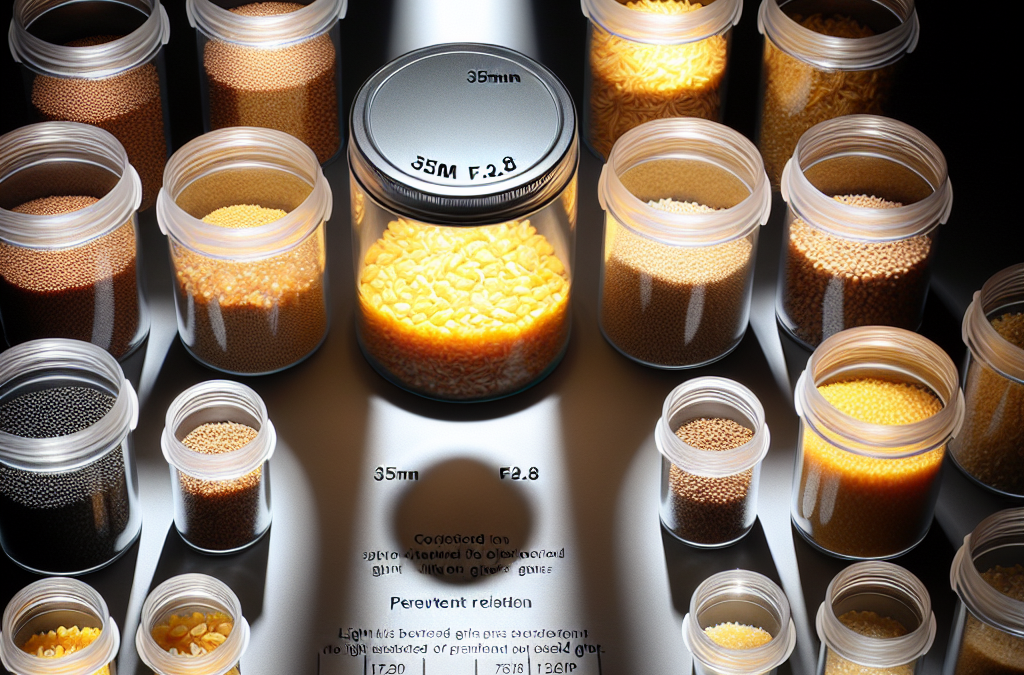Understanding Light’s Role in Grain Storage
How Light Affects Grain Quality
Let me share something I’ve learned over the years: light plays a surprisingly significant role in how well grains hold up during storage. When grains are exposed to light, especially UV light, several processes kick in that adversely affect their quality. For starters, light can lead to oxidation, impacting nutrients, colors, and flavors.
Oxidation isn’t just some technical term – it essentially means that certain beneficial compounds in the grains start to break down, especially vitamins. This breakdown can lead to a diminished nutritional value, and nobody wants to compromise on that, right?
So, the next time you’re thinking about how to store grains, remember that keeping them out of light isn’t just an afterthought; it’s a crucial part of preserving their integrity and, ultimately, ensuring they stay as healthy as possible.
Types of Light and Their Effects
Different types of light have varying effects on stored grains. Let’s break it down! Firstly, natural sunlight can be quite detrimental. The strong UV rays can cause rapid deterioration of grain quality.
Then, there’s artificial light. It might seem like a lesser evil, but fluorescent and halogen lights can also emit UV rays that are harmful over time. I’ve seen this firsthand in storage facilities; some folks underestimate the impact of those lightbulbs!
Lastly, let’s not forget about heat. It often accompanies light exposure, further exacerbating the damage. High temperatures can speed up the deterioration process, making it double trouble for our beloved grains.
The Science Behind Light Sensitivity
Okay, so why do grains even care about light? It mainly has to do with their chemical makeup. In grains, there are certain pigments and compounds that react negatively when exposed to light. One prime example is carotenoids. They might sound fancy, but they’re responsible for giving color and healthy benefits to grains.
Sadly, these beneficial pigments can break down when hit by light, leading to loss of color and nutrients. It’s like watching your favorite plant wilt in the sun – no fun at all!
And, you know what else? This light exposure can also trigger enzymatic reactions that further harm the grains. So storing them away from light is not just an option; it’s a necessity for anyone who wants to keep their grains in top-notch condition.
Identifying Sources of Light in Storage Areas
Assessing the Storage Environment
When I first started dealing with grain storage, I had no clue how crucial a simple environmental assessment could be. I learned that the first step is to take a good look around. Are there windows letting in sunlight? Is the storage area near a frequently used light source?
I remember one time, I rented a storage unit that had big windows. I thought it was great for ventilation, but boy, did it lead to some unhappy grains after a few weeks. Conducting an assessment can save a lot of headaches!
So, grab a notepad and jot down potential light sources. Keeping track of where the light is coming from can help you strategize how to mitigate its effects on your stored grains.
Using Materials to Block Light
Once you know where the light is coming from, it’s time to get crafty. I found that using specific materials can be a game-changer in blocking that pesky light. For instance, heavy curtains or blackout shades in storage areas can make a huge difference.
If you’re building a storage facility, consider using materials like black plastic sheeting—it’s relatively cheap and super effective at keeping light out. Trust me; you want to do everything you can to keep your grains safe.
Additionally, some people have had success with opaque storage containers. Using bins that don’t let any light in is a hassle-free way to ensure your grains are shielded from unwanted exposure.
Establishing Proper Storage Practices
It’s not enough to just block light; you’ve got to set proper storage practices in place. One thing I’ve learned is the importance of rotating your stock. Moving older grains to the front and storing newer ones at the back can ensure that nothing sits around long enough to be damaged by light, even if it’s just a little.
Another key practice is sealing bags tightly—this reduces the chances of light creeping in. I always keep my bags zipped properly; it’s just one more way to ensure the longevity of my grains.
And lastly, make it a habit to regularly check your storage. Familiarizing yourself with the space helps to keep an eye on any potential light problems before they escalate. You’d be surprised at what you find after a thorough check!
Implementing Light Management Strategies
Investing in Technology
In today’s world, tech isn’t just for flashy gadgets; it can help manage light in grain storage too! I discovered that there are some amazing sensors available that can monitor light exposure in storages in real-time. These little devices can alert you if light levels increase beyond acceptable thresholds.
Some advanced setups even allow for remote monitoring so that you can keep tabs while sipping your coffee at home. Investing in this tech can be a bit pricy upfront, but in the long run, it saves you from losing quality grains!
This was a huge eye-opener for me; the peace of mind that comes with knowing my grains are protected is absolutely worth it.
Get Whole Wheat Flour, Grains and Milling Supplies – CLICK HERE
Community Solutions
Don’t underestimate the power of community; brainstorming with others about light management strategies can yield incredible solutions. I’ve had some fantastic discussions at local farmer’s markets where we swapped tips and tricks on how to keep grains safe from light.
Collaborating with others in your area may also lead to sharing resources such as bulk buying materials to block out light or creating community storage spaces that are purposely built to minimize light exposure.
It’s also a great opportunity to learn from others’ experiences! I love hearing stories from fellow grain producers and applying what’s worked for them to my own practices.
Education and Training
Lastly, never underestimate the power of education. Workshops, online courses, and seminars about grain storage management can equip you with the latest and greatest techniques for handling light exposure. I once attended a workshop focused specifically on light management, and it was a game changer.
The more I learned, the better my storage practices became. Plus, I made connections with other grain enthusiasts which created an amazing support network. You never know what insight others might share!
So, whether you read a book or chat with seasoned experts, investing time in education can truly pay off in the long run.
Maintaining a Light-Free Zone
Creating Sustainable Practices
One thing I’ve realized is that maintaining a light-free zone isn’t just a one-off task; it’s an ongoing commitment. Developing sustainable practices can ensure that grains remain protected from light exposure continuously. This includes regular maintenance of storage areas.
I often find myself doing quick checks to ensure nothing has changed or gotten damaged that might let light in. It’s all about being adaptable and ready to tweak your setup as needed.
Long-term sustainability also involves being mindful of the materials you use. Choose materials that are durable and effective at blocking out light, which can save you from having to replace things frequently. Trust me, it feels good to invest in quality!
Regular Review and Adjustments
Another pro tip is to schedule regular reviews of your grain storage practices. This might seem tedious, but I can assure you it’s worth it. An accessible checklist can keep track of light sources, storage conditions, and anything that needs to be fixed.
During these reviews, I also ask myself what strategies have worked and if there’s anything new I can incorporate. Just keeping your mind open to innovation can lead to some incredible improvements!
It’s about making small adjustments over time that can cumulate into significant results regarding your grain preservation under light exposure.
Sharing Insights with Others
Lastly, once you’ve got the hang of managing light exposure, don’t keep that knowledge to yourself. Share your insights with fellow grain producers! I make it a point to have discussions about what works in our various environments and how we can help each other.
Creating workshops or even informal meetups to discuss these practices can foster a sense of community. Plus, sharing our experiences can open doors to new ideas and solutions we might not have come across individually.
It’s all about lifting each other up; sharing what I’ve learned has only enriched my own practices as well.
Frequently Asked Questions (FAQ)
1. How does light affect the quality of stored grains?
Light exposure, particularly UV light, leads to oxidation and nutrient breakdown, diminishing both flavor and nutritional value. Keeping grains in the dark is crucial to preserving their quality.
2. What can I use to block light in my grain storage?
Heavy curtains, blackout shades, opaque storage bins, and black plastic sheeting can be highly effective materials for blocking light and protecting your stored grains.
3. How often should I check my grain storage areas?
Regular checks are essential. I recommend inspecting your storage at least once a month—this helps catch any light exposure issues before they damage your grains.
4. Is technology helpful for light management in grain storage?
Absolutely! Investing in light sensors and monitoring technology can alert you to changes in light exposure, allowing for proactive measures to protect your grain quality.
5. What is the best long-term strategy to manage light exposure?
Creating sustainable practices, regularly reviewing your setup, and sharing insights with fellow grain producers are key. Building a community and continuously improving are vital for successful light management.
Get Whole Wheat Flour, Grains and Milling Supplies – CLICK HERE
Related Content
Auto Amazon Links: No products found.





